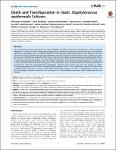Death and Transfiguration in Static Staphylococcus epidermidis Cultures
Schaudinn, Christoph
Stoodley, Paul
Hall-Stoodley, Luanne
Gorur, Amita
Remis, Jonathan
Wu, Siva
Auer, Manfred
Hertwig, Stefan
Guerrero-Given, Debbie
Hu, Fen Ze
Ehrlich, Garth D.
Costerton, John William
Robinson, Douglas H.
Webster, Paul
The overwhelming majority of bacteria live in slime embedded microbial communities termed biofilms, which are typically adherent to a surface. However, when several Staphylococcus epidermidis strains were cultivated in static liquid cultures, macroscopic aggregates were seen floating within the broth and also sedimented at the test tube bottom. Light- and electron microscopy revealed that early-stage aggregates consisted of bacteria and extracellular matrix, organized in sheet-like structures. Perpendicular under the sheets hung a network of periodically arranged, bacteria-associated strands. During the extended cultivation, the strands of a subpopulation of aggregates developed into cross-connected wall-like structures, in which aligned bacteria formed the walls. The resulting architecture had a compartmentalized appearance. In late-stage cultures, the wall-associated bacteria disintegrated so that, henceforth, the walls were made of the coalescing remnants of lysed bacteria, while the compartment-like organization remained intact. At the same time, the majority of strand-containing aggregates with associated culturable bacteria continued to exist. These observations indicate that some strains of Staphylococcus epidermidis are able to build highly sophisticated structures, in which a subpopulation undergoes cell lysis, presumably to provide continued access to nutrients in a nutrient-limited environment, whilst maintaining structural integrity.
No license information

